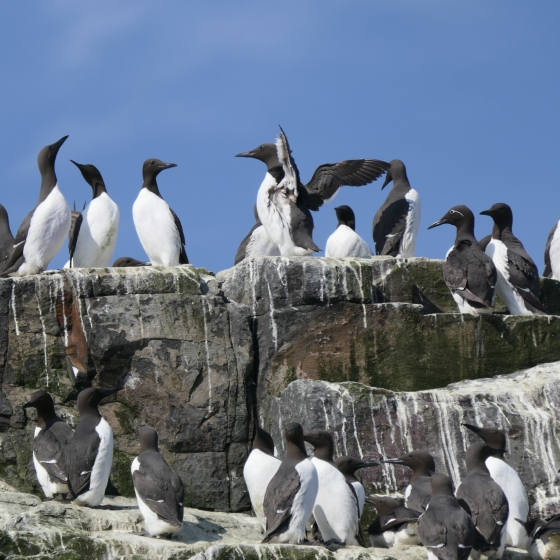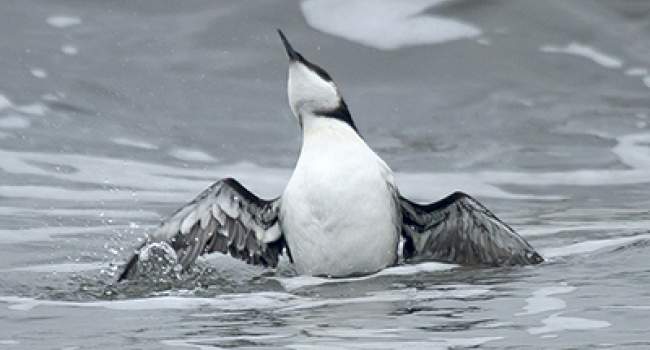Guillemot
Uria aalge (Pontoppidan, 1763)
GU
 GUILL
GUILL  6340
6340

Family: Charadriiformes > Alcidae

Guillemots breed on rocky cliffs, using narrow ledges, and their colonies can be found around much of our coastline, including on isolated seastacks and suitable island outcrops.
Colonial breeding is the norm in this species and some colonies may number tens of thousands of individuals. Nest site locations vary between sites, with mainland sites restricted to narrow ledges safe from predators; on predator-free islands pairs may nest among rocks or even on bare ground.
During the winter months Guillemots may be encountered widely in coastal waters, though these birds are most abundant in those of the northern North Sea and off our western shores.
Identification
Guillemot identification is usually straightforward. The following article may help when identifying Guillemot.
Identifying winter Auks

Summer Auks, in breeding plumage, at the shore or near to their colonies are relatively easy to identify. But in autumn and winter we tend to see them flying rapidly past, far offshore, or bobbing around in heavy seas offering poor views. When you add to this that their distinctive breeding plumage and colouring is lost, winter Auks can be a serious challenge to identify and separate.
SONGS AND CALLS
Listen to example recordings of the main vocalisations of Guillemot, provided by xeno-canto contributors.
Call
Song
Develop your bird ID skills with our training courses
Our interactive online courses are a great way to develop your bird identification skills, whether you're new to the hobby or a competent birder looking to hone your abilities.
Browse training coursesStatus and Trends
Population size and trends and patterns of distribution based on BTO surveys and atlases with data collected by BTO volunteers.
CONSERVATION STATUS
This species can be found on the following statutory and conservation listings and schedules.
DISTRIBUTION
During winter, Guillemots are found around much of the coast of Britain & Ireland with the highest densities in west-coast waters and the North Sea coast of southeast Scotland and northeast England. Guillemot colonies are associated with steep cliffs and rocky offshore stacks and islands, and the lack of these habitats between Flamborough Head, Yorkshire and Durlston Head, Dorset is mirrored in the breeding distribution map.
Occupied 10-km squares in UK
| No. occupied in breeding season | 231 |
| % occupied in breeding season | 7.6 |
| No. occupied in winter | 558 |
| % occupied in winter | 18 |
European Distribution Map
DISTRIBUTION CHANGE
Change in occupied 10-km squares in the UK
| % change in range in breeding season (1968–72 to 2008–11) | -16.7% |
| % change in range in winter (1981–84 to 2007–11) | --21% |
SEASONALITY
Guillemots are recorded throughout the year though more consistently during summer at suitable coastal breeding sites.

Movement
Information about movement and migration based on online bird portals (e.g. BirdTrack), Ringing schemes and tracking studies.
RINGING RECOVERIES
View a summary of recoveries in the Online Ringing Report.
Foreign locations of birds ringed or recovered in Britain & Ireland

Biology
Lifecycle and body size information about Guillemot, including statistics on nesting, eggs and lifespan based on BTO ringing and nest recording data.
SURVIVAL & LONGEVITY
View number ringed each year in the Online Ringing Report
Maximum Age from Ringing 
|
40 years 11 months 23 days (set in 2019) 
|
Typical Lifespan 
|
23 years with breeding typically at 5 year |
Adult Survival 
|
0.946  
|
Juvenile Survival 
|
0.56 (in first year) 
|
BIOMETRICS
Wing Length 
|
Adults | 203.3±7.2 | Range 194–211mm, N=691 |
Body Weight 
|
Adults | 891±73.8 | Range 770–1010g, N=994 |
Feather measurements and photos on featherbase 
CODES & CLASSIFICATION
Ring size 
|
Special |
Field Codes 
|
2-letter: GU | 5-letter code: GUILL | Euring: 6340 |
For information in another language (where available) click on a linked name
Links to more studies from ConservationEvidence.com
- How to prioritize rat management for the benefit of petrels: a case study of the UK, Channel Islands and Isle of Man
- Supplementary feeding of young puffins, Fratercula arctica
- Re-establishment of Atlantic puffins (Fratercula arctica) at a former breeding site in the Gulf of Maine
Read more studies about Guillemot on Conservation Evidence >
Would you like to search for another species?











Share this page